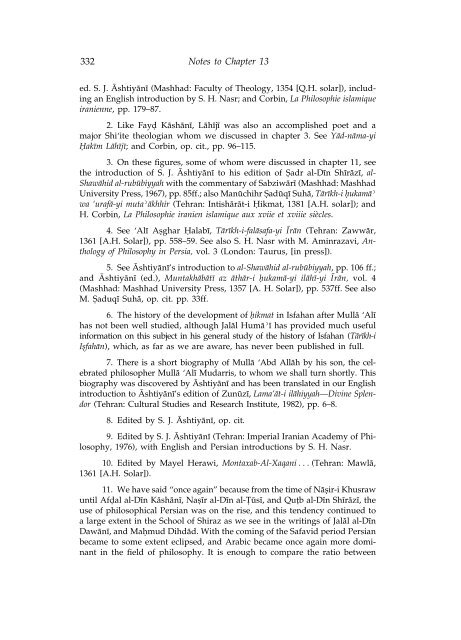Islamic Philosophy from Its Origin to the Present: Philosophy in the ...
Islamic Philosophy from Its Origin to the Present: Philosophy in the ...
Islamic Philosophy from Its Origin to the Present: Philosophy in the ...
You also want an ePaper? Increase the reach of your titles
YUMPU automatically turns print PDFs into web optimized ePapers that Google loves.
332 Notes <strong>to</strong> Chapter 13<br />
ed. S. J. ≈shtiyån¥ (Mashhad: Faculty of Theology, 1354 [Q.H. solar]), <strong>in</strong>clud<strong>in</strong>g<br />
an English <strong>in</strong>troduction by S. H. Nasr; and Corb<strong>in</strong>, La Philosophie islamique<br />
iranienne, pp. 179–87.<br />
2. Like Fay∂ Kåshån¥, Låh¥j¥ was also an accomplished poet and a<br />
major Shi‘ite <strong>the</strong>ologian whom we discussed <strong>in</strong> chapter 3. See Yåd-nåma-yi<br />
¡ak¥m Låh¥j¥; and Corb<strong>in</strong>, op. cit., pp. 96–115.<br />
3. On <strong>the</strong>se figures, some of whom were discussed <strong>in</strong> chapter 11, see<br />
<strong>the</strong> <strong>in</strong>troduction of S. J. ≈shtiyån¥ <strong>to</strong> his edition of |adr al-D¥n Sh¥råz¥, al-<br />
Shawåhid al-rub¶biyyah with <strong>the</strong> commentary of Sabziwår¥ (Mashhad: Mashhad<br />
University Press, 1967), pp. 85ff.; also Man¨chihr |ad¨q¥ Suhå, Tår¥kh-i ÷ukamå˘<br />
wa ‘urafå-yi muta˘åkhhir (Tehran: Intishåråt-i ¡ikmat, 1381 [A.H. solar]); and<br />
H. Corb<strong>in</strong>, La Philosophie iranien islamique aux xviie et xviiie siècles.<br />
4. See ‘Al¥ A∑ghar ¡alab¥, Tår¥kh-i-falåsafa-yi Īrån (Tehran: Zawwår,<br />
1361 [A.H. Solar]), pp. 558–59. See also S. H. Nasr with M. Am<strong>in</strong>razavi, Anthology<br />
of <strong>Philosophy</strong> <strong>in</strong> Persia, vol. 3 (London: Taurus, [<strong>in</strong> press]).<br />
5. See ≈shtiyån¥’s <strong>in</strong>troduction <strong>to</strong> al-Shawåhid al-rub¶biyyah, pp. 106 ff.;<br />
and ≈shtiyån¥ (ed.), Muntakhåbåt¥ az åthår-i ÷ukamå-yi ilåh¥-yi Īrån, vol. 4<br />
(Mashhad: Mashhad University Press, 1357 [A. H. Solar]), pp. 537ff. See also<br />
M. |aduq¥ Suhå, op. cit. pp. 33ff.<br />
6. The his<strong>to</strong>ry of <strong>the</strong> development of ÷ikmat <strong>in</strong> Isfahan after Mullå ‘Al¥<br />
has not been well studied, although Jalål Humå˘¥ has provided much useful<br />
<strong>in</strong>formation on this subject <strong>in</strong> his general study of <strong>the</strong> his<strong>to</strong>ry of Isfahan (Tår¥kh-i<br />
Iƒfahån), which, as far as we are aware, has never been published <strong>in</strong> full.<br />
7. There is a short biography of Mullå ‘Abd Allåh by his son, <strong>the</strong> celebrated<br />
philosopher Mullå ‘Al¥ Mudarris, <strong>to</strong> whom we shall turn shortly. This<br />
biography was discovered by ≈shtiyån¥ and has been translated <strong>in</strong> our English<br />
<strong>in</strong>troduction <strong>to</strong> ≈shtiyån¥’s edition of Zun¨z¥, Lama‘åt-i ilåhiyyah—Div<strong>in</strong>e Splendor<br />
(Tehran: Cultural Studies and Research Institute, 1982), pp. 6–8.<br />
8. Edited by S. J. ≈shtiyån¥, op. cit.<br />
9. Edited by S. J. ≈shtiyån¥ (Tehran: Imperial Iranian Academy of <strong>Philosophy</strong>,<br />
1976), with English and Persian <strong>in</strong>troductions by S. H. Nasr.<br />
10. Edited by Mayel Herawi, Montaxab-Al-Xaqani . . . (Tehran: Mawlå,<br />
1361 [A.H. Solar]).<br />
11. We have said “once aga<strong>in</strong>” because <strong>from</strong> <strong>the</strong> time of Nå∑ir-i Khusraw<br />
until Af∂al al-D¥n Kåshån¥, Na∑¥r al-D¥n al-apple¨s¥, and Qu†b al-D¥n Sh¥råz¥, <strong>the</strong><br />
use of philosophical Persian was on <strong>the</strong> rise, and this tendency cont<strong>in</strong>ued <strong>to</strong><br />
a large extent <strong>in</strong> <strong>the</strong> School of Shiraz as we see <strong>in</strong> <strong>the</strong> writ<strong>in</strong>gs of Jalål al-D¥n<br />
Dawån¥, and Ma±mud Dihdåd. With <strong>the</strong> com<strong>in</strong>g of <strong>the</strong> Safavid period Persian<br />
became <strong>to</strong> some extent eclipsed, and Arabic became once aga<strong>in</strong> more dom<strong>in</strong>ant<br />
<strong>in</strong> <strong>the</strong> field of philosophy. It is enough <strong>to</strong> compare <strong>the</strong> ratio between

















